Risk Assessments in the Criminal Justice System: An In-depth Analysis
VerifiedAdded on 2022/10/12
|8
|2381
|351
Essay
AI Summary
This essay delves into the significance of risk assessments within the criminal justice system (CJS), emphasizing their critical role in predicting offender behavior and determining the likelihood of reoffending. It defines risk assessment and explores its application in the CJS, including sentencing and rehabilitation processes. The essay examines two primary approaches: clinical methods, which rely on expert judgment, and actuarial methods, which utilize statistical algorithms. It outlines the pros and cons of each approach, evaluating their accuracy and reliability based on empirical evidence. The discussion encompasses the accuracy of risk assessment measures used in the CJS, highlighting the debate surrounding the effectiveness of clinical versus actuarial methods. The essay argues the importance of risk assessments for the CJS, while acknowledging the potential limitations, and concludes by emphasizing the value of structured clinical judgment combined with actuarial data for more accurate predictions. This analysis underscores the complexity of predicting human behavior, particularly in individuals with anti-social tendencies, reinforcing the need for well-informed risk assessment tools in the CJS.
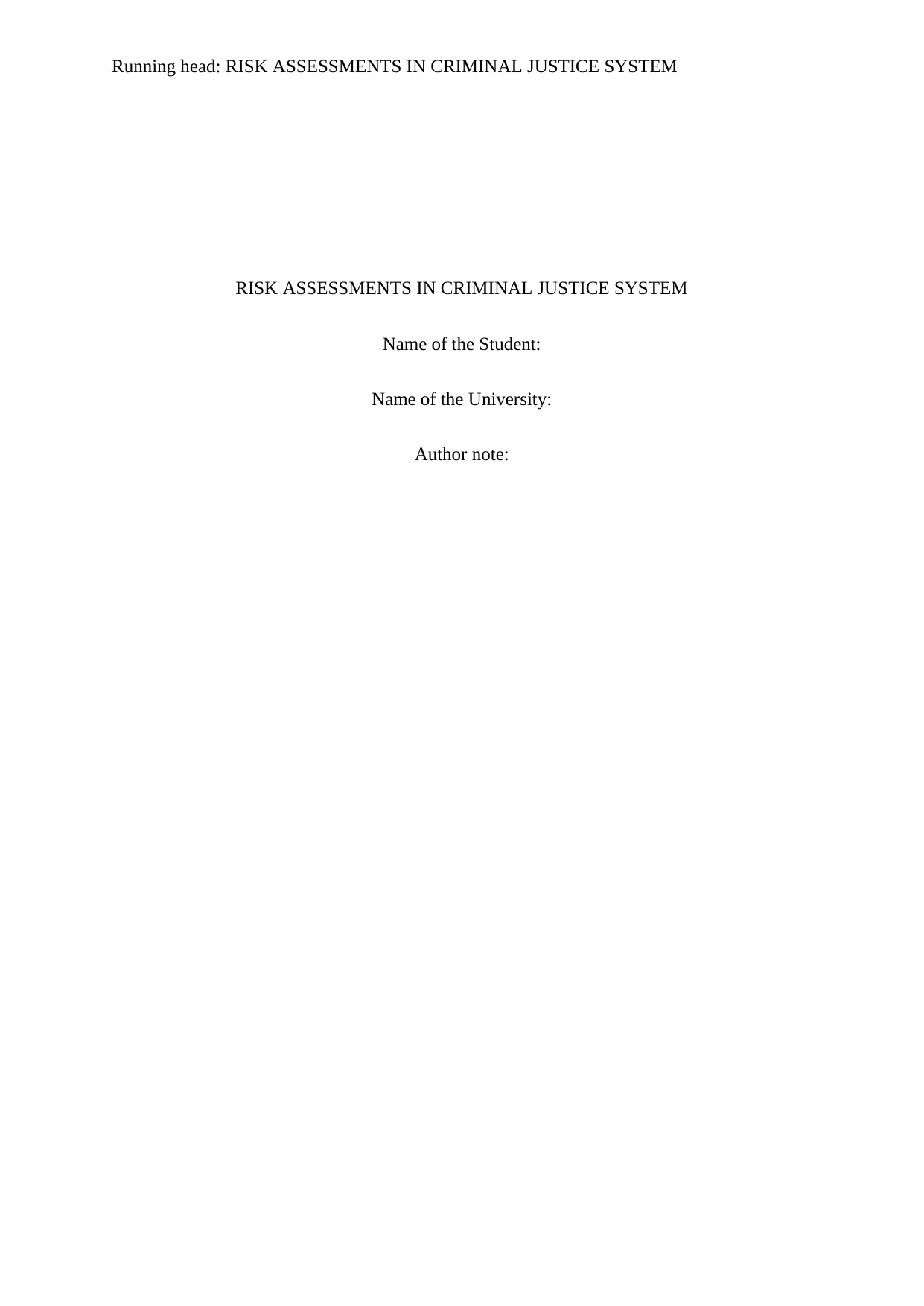
Running head: RISK ASSESSMENTS IN CRIMINAL JUSTICE SYSTEM
RISK ASSESSMENTS IN CRIMINAL JUSTICE SYSTEM
Name of the Student:
Name of the University:
Author note:
RISK ASSESSMENTS IN CRIMINAL JUSTICE SYSTEM
Name of the Student:
Name of the University:
Author note:
Paraphrase This Document
Need a fresh take? Get an instant paraphrase of this document with our AI Paraphraser
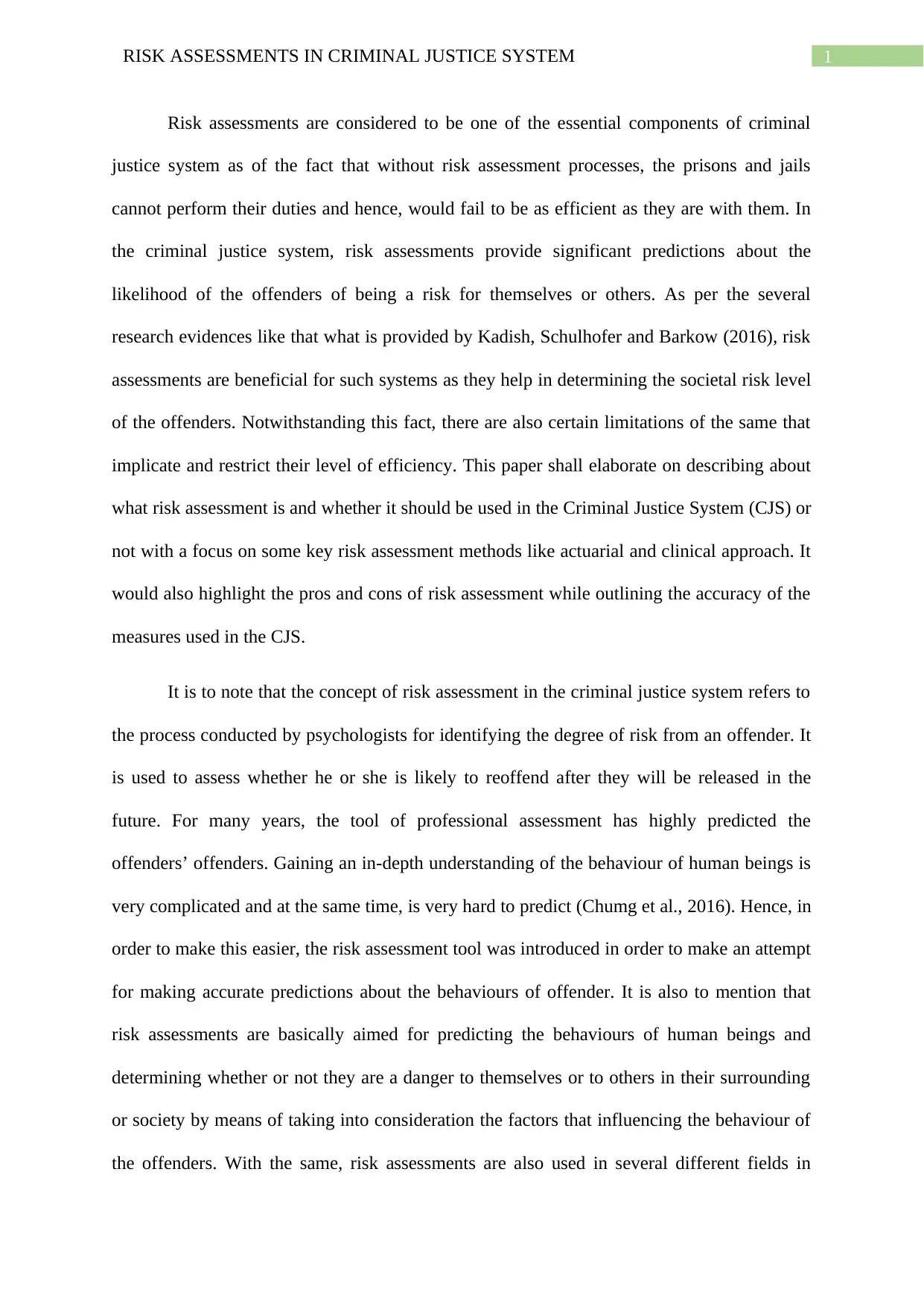
1RISK ASSESSMENTS IN CRIMINAL JUSTICE SYSTEM
Risk assessments are considered to be one of the essential components of criminal
justice system as of the fact that without risk assessment processes, the prisons and jails
cannot perform their duties and hence, would fail to be as efficient as they are with them. In
the criminal justice system, risk assessments provide significant predictions about the
likelihood of the offenders of being a risk for themselves or others. As per the several
research evidences like that what is provided by Kadish, Schulhofer and Barkow (2016), risk
assessments are beneficial for such systems as they help in determining the societal risk level
of the offenders. Notwithstanding this fact, there are also certain limitations of the same that
implicate and restrict their level of efficiency. This paper shall elaborate on describing about
what risk assessment is and whether it should be used in the Criminal Justice System (CJS) or
not with a focus on some key risk assessment methods like actuarial and clinical approach. It
would also highlight the pros and cons of risk assessment while outlining the accuracy of the
measures used in the CJS.
It is to note that the concept of risk assessment in the criminal justice system refers to
the process conducted by psychologists for identifying the degree of risk from an offender. It
is used to assess whether he or she is likely to reoffend after they will be released in the
future. For many years, the tool of professional assessment has highly predicted the
offenders’ offenders. Gaining an in-depth understanding of the behaviour of human beings is
very complicated and at the same time, is very hard to predict (Chumg et al., 2016). Hence, in
order to make this easier, the risk assessment tool was introduced in order to make an attempt
for making accurate predictions about the behaviours of offender. It is also to mention that
risk assessments are basically aimed for predicting the behaviours of human beings and
determining whether or not they are a danger to themselves or to others in their surrounding
or society by means of taking into consideration the factors that influencing the behaviour of
the offenders. With the same, risk assessments are also used in several different fields in
Risk assessments are considered to be one of the essential components of criminal
justice system as of the fact that without risk assessment processes, the prisons and jails
cannot perform their duties and hence, would fail to be as efficient as they are with them. In
the criminal justice system, risk assessments provide significant predictions about the
likelihood of the offenders of being a risk for themselves or others. As per the several
research evidences like that what is provided by Kadish, Schulhofer and Barkow (2016), risk
assessments are beneficial for such systems as they help in determining the societal risk level
of the offenders. Notwithstanding this fact, there are also certain limitations of the same that
implicate and restrict their level of efficiency. This paper shall elaborate on describing about
what risk assessment is and whether it should be used in the Criminal Justice System (CJS) or
not with a focus on some key risk assessment methods like actuarial and clinical approach. It
would also highlight the pros and cons of risk assessment while outlining the accuracy of the
measures used in the CJS.
It is to note that the concept of risk assessment in the criminal justice system refers to
the process conducted by psychologists for identifying the degree of risk from an offender. It
is used to assess whether he or she is likely to reoffend after they will be released in the
future. For many years, the tool of professional assessment has highly predicted the
offenders’ offenders. Gaining an in-depth understanding of the behaviour of human beings is
very complicated and at the same time, is very hard to predict (Chumg et al., 2016). Hence, in
order to make this easier, the risk assessment tool was introduced in order to make an attempt
for making accurate predictions about the behaviours of offender. It is also to mention that
risk assessments are basically aimed for predicting the behaviours of human beings and
determining whether or not they are a danger to themselves or to others in their surrounding
or society by means of taking into consideration the factors that influencing the behaviour of
the offenders. With the same, risk assessments are also used in several different fields in
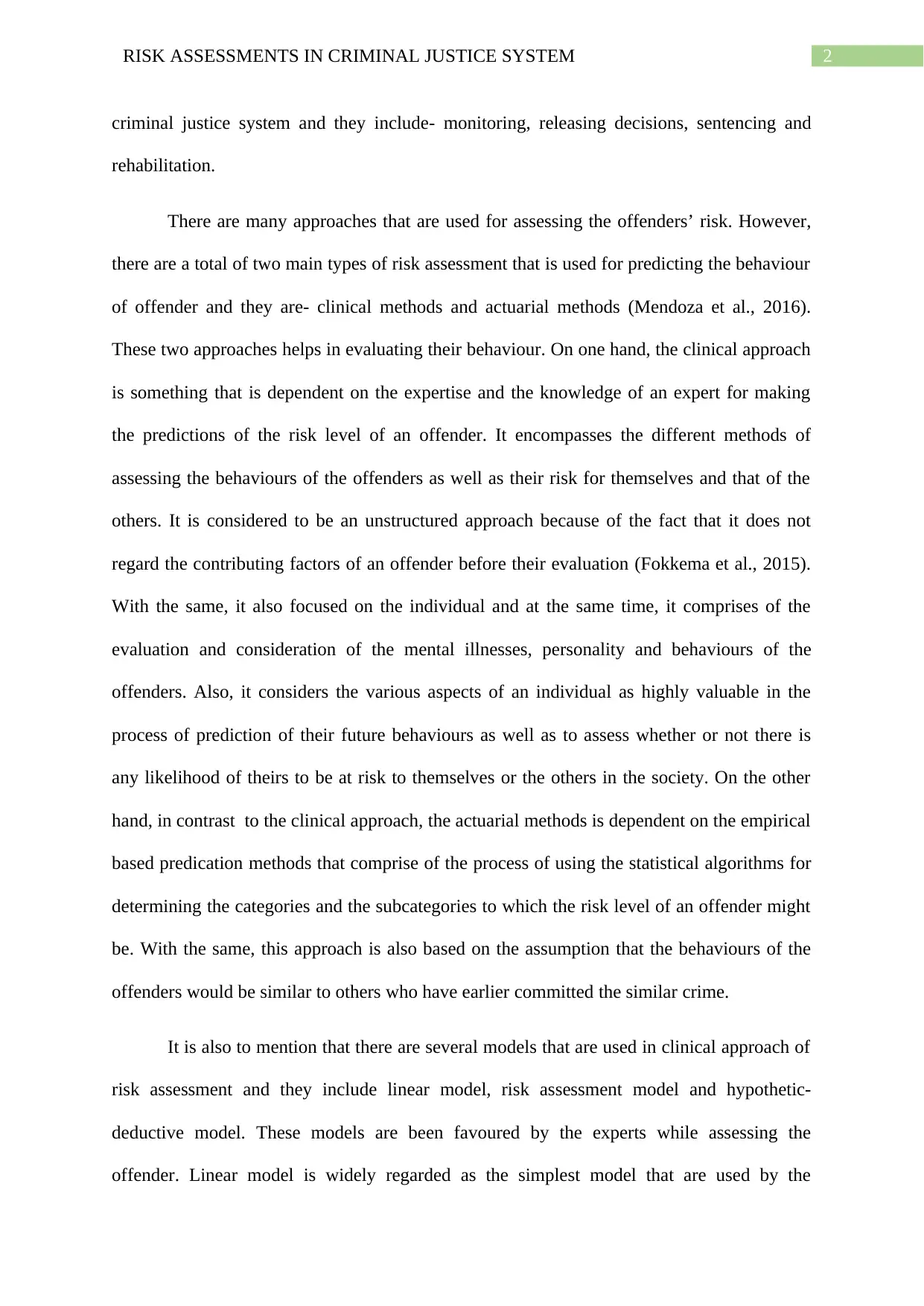
2RISK ASSESSMENTS IN CRIMINAL JUSTICE SYSTEM
criminal justice system and they include- monitoring, releasing decisions, sentencing and
rehabilitation.
There are many approaches that are used for assessing the offenders’ risk. However,
there are a total of two main types of risk assessment that is used for predicting the behaviour
of offender and they are- clinical methods and actuarial methods (Mendoza et al., 2016).
These two approaches helps in evaluating their behaviour. On one hand, the clinical approach
is something that is dependent on the expertise and the knowledge of an expert for making
the predictions of the risk level of an offender. It encompasses the different methods of
assessing the behaviours of the offenders as well as their risk for themselves and that of the
others. It is considered to be an unstructured approach because of the fact that it does not
regard the contributing factors of an offender before their evaluation (Fokkema et al., 2015).
With the same, it also focused on the individual and at the same time, it comprises of the
evaluation and consideration of the mental illnesses, personality and behaviours of the
offenders. Also, it considers the various aspects of an individual as highly valuable in the
process of prediction of their future behaviours as well as to assess whether or not there is
any likelihood of theirs to be at risk to themselves or the others in the society. On the other
hand, in contrast to the clinical approach, the actuarial methods is dependent on the empirical
based predication methods that comprise of the process of using the statistical algorithms for
determining the categories and the subcategories to which the risk level of an offender might
be. With the same, this approach is also based on the assumption that the behaviours of the
offenders would be similar to others who have earlier committed the similar crime.
It is also to mention that there are several models that are used in clinical approach of
risk assessment and they include linear model, risk assessment model and hypothetic-
deductive model. These models are been favoured by the experts while assessing the
offender. Linear model is widely regarded as the simplest model that are used by the
criminal justice system and they include- monitoring, releasing decisions, sentencing and
rehabilitation.
There are many approaches that are used for assessing the offenders’ risk. However,
there are a total of two main types of risk assessment that is used for predicting the behaviour
of offender and they are- clinical methods and actuarial methods (Mendoza et al., 2016).
These two approaches helps in evaluating their behaviour. On one hand, the clinical approach
is something that is dependent on the expertise and the knowledge of an expert for making
the predictions of the risk level of an offender. It encompasses the different methods of
assessing the behaviours of the offenders as well as their risk for themselves and that of the
others. It is considered to be an unstructured approach because of the fact that it does not
regard the contributing factors of an offender before their evaluation (Fokkema et al., 2015).
With the same, it also focused on the individual and at the same time, it comprises of the
evaluation and consideration of the mental illnesses, personality and behaviours of the
offenders. Also, it considers the various aspects of an individual as highly valuable in the
process of prediction of their future behaviours as well as to assess whether or not there is
any likelihood of theirs to be at risk to themselves or the others in the society. On the other
hand, in contrast to the clinical approach, the actuarial methods is dependent on the empirical
based predication methods that comprise of the process of using the statistical algorithms for
determining the categories and the subcategories to which the risk level of an offender might
be. With the same, this approach is also based on the assumption that the behaviours of the
offenders would be similar to others who have earlier committed the similar crime.
It is also to mention that there are several models that are used in clinical approach of
risk assessment and they include linear model, risk assessment model and hypothetic-
deductive model. These models are been favoured by the experts while assessing the
offender. Linear model is widely regarded as the simplest model that are used by the
⊘ This is a preview!⊘
Do you want full access?
Subscribe today to unlock all pages.

Trusted by 1+ million students worldwide

3RISK ASSESSMENTS IN CRIMINAL JUSTICE SYSTEM
psychiatrist and psychologist for assessing the behaviour of the offenders. It is based on the
flow diagram which illustrates a wide number of offender’s decision choices (Berk & Hyatt,
2015). This diagram is being used as guide for the expert that help them in gaging whether a
person illustrates some dangerous behaviours. On the basis of the responses provided by the
offender, experts then carry out the most proper actions as per the flow diagram. With the
same, the hypothetic-deductive approach needs the clinicians for creating a hypothesis
regarding the potential future of the offender’s behaviours by means of examining their
earlier behaviours. It depends on the experience and the expertise of the clinician for
determining what cues resulted in the formation of certain behaviours that the offenders did
in the past.
Furthermore, it is also to mention that the risk assessment model also helps in
evaluating the complexity of violence (Sarma, 2017). It is an approach that does not just
evaluate the characteristics of an individual, but at the same time, also the social
environments and contexts in which the individual interacts. It is to note that from the risk
assessment model, the clinicians are required to be informed about the surroundings in which
the offender would be involved as it can help inn predicting the possibilities of reoffending
the same thing again or different thing is same way (Poldrack et al., 2018). As of the fact that
the clinical approach depends on the expert as well as their experience, therefore, the validity
of the risk assessments process for the determination of the level of risk of an offender is
debatable.
The pros and cons of the risk assessments for determining their accuracy is very
important to consider. It is to note that the term “accuracy” in CJS is all about the
effectiveness and efficiency of the risk assessments for determining the level of risk by an
offender to the society. On the basis of which this method is used, whether clinical or
actuarial, the accuracy of risk assessment is determined. According to Weine et al. (2017),
psychiatrist and psychologist for assessing the behaviour of the offenders. It is based on the
flow diagram which illustrates a wide number of offender’s decision choices (Berk & Hyatt,
2015). This diagram is being used as guide for the expert that help them in gaging whether a
person illustrates some dangerous behaviours. On the basis of the responses provided by the
offender, experts then carry out the most proper actions as per the flow diagram. With the
same, the hypothetic-deductive approach needs the clinicians for creating a hypothesis
regarding the potential future of the offender’s behaviours by means of examining their
earlier behaviours. It depends on the experience and the expertise of the clinician for
determining what cues resulted in the formation of certain behaviours that the offenders did
in the past.
Furthermore, it is also to mention that the risk assessment model also helps in
evaluating the complexity of violence (Sarma, 2017). It is an approach that does not just
evaluate the characteristics of an individual, but at the same time, also the social
environments and contexts in which the individual interacts. It is to note that from the risk
assessment model, the clinicians are required to be informed about the surroundings in which
the offender would be involved as it can help inn predicting the possibilities of reoffending
the same thing again or different thing is same way (Poldrack et al., 2018). As of the fact that
the clinical approach depends on the expert as well as their experience, therefore, the validity
of the risk assessments process for the determination of the level of risk of an offender is
debatable.
The pros and cons of the risk assessments for determining their accuracy is very
important to consider. It is to note that the term “accuracy” in CJS is all about the
effectiveness and efficiency of the risk assessments for determining the level of risk by an
offender to the society. On the basis of which this method is used, whether clinical or
actuarial, the accuracy of risk assessment is determined. According to Weine et al. (2017),
Paraphrase This Document
Need a fresh take? Get an instant paraphrase of this document with our AI Paraphraser
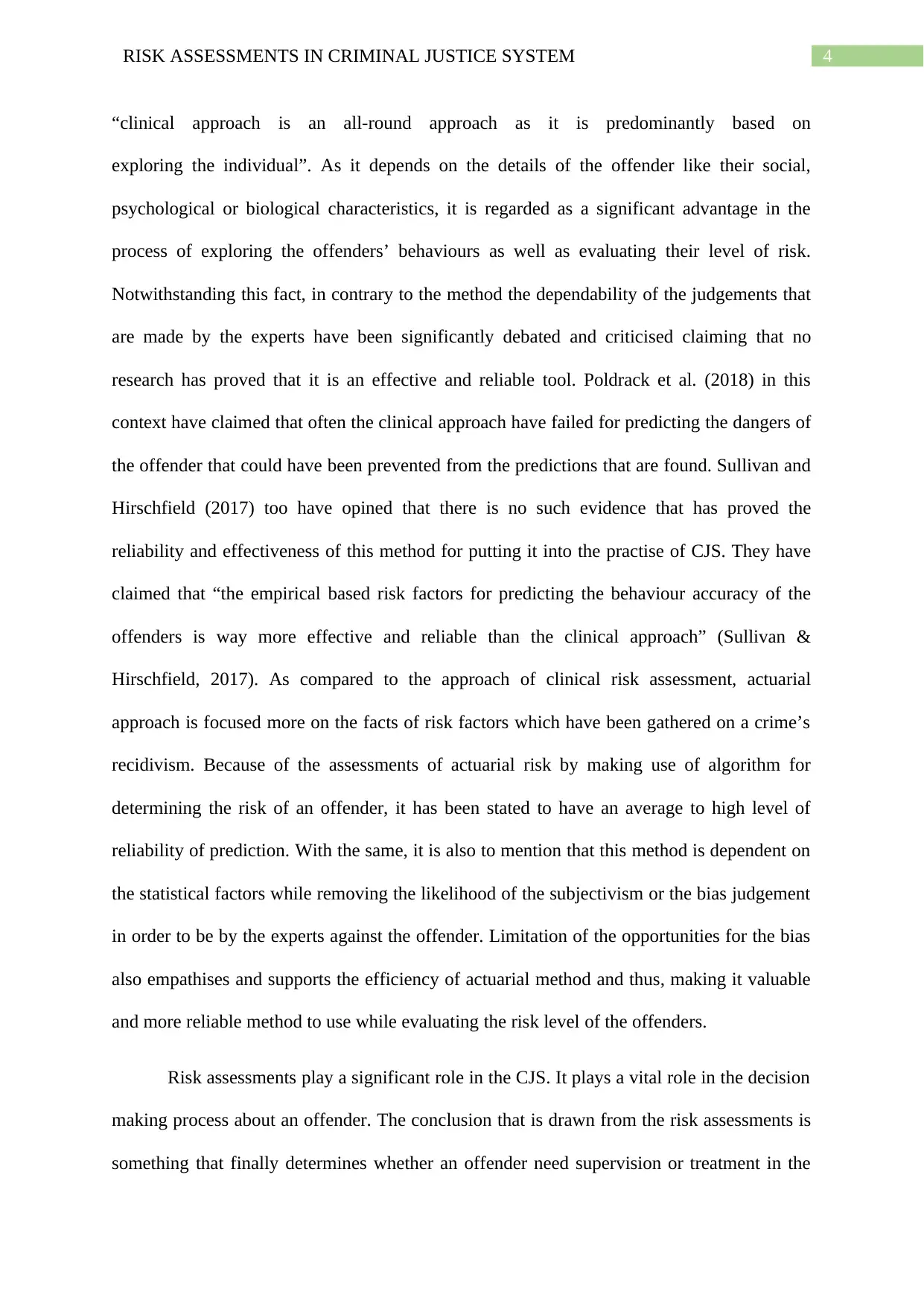
4RISK ASSESSMENTS IN CRIMINAL JUSTICE SYSTEM
“clinical approach is an all-round approach as it is predominantly based on
exploring the individual”. As it depends on the details of the offender like their social,
psychological or biological characteristics, it is regarded as a significant advantage in the
process of exploring the offenders’ behaviours as well as evaluating their level of risk.
Notwithstanding this fact, in contrary to the method the dependability of the judgements that
are made by the experts have been significantly debated and criticised claiming that no
research has proved that it is an effective and reliable tool. Poldrack et al. (2018) in this
context have claimed that often the clinical approach have failed for predicting the dangers of
the offender that could have been prevented from the predictions that are found. Sullivan and
Hirschfield (2017) too have opined that there is no such evidence that has proved the
reliability and effectiveness of this method for putting it into the practise of CJS. They have
claimed that “the empirical based risk factors for predicting the behaviour accuracy of the
offenders is way more effective and reliable than the clinical approach” (Sullivan &
Hirschfield, 2017). As compared to the approach of clinical risk assessment, actuarial
approach is focused more on the facts of risk factors which have been gathered on a crime’s
recidivism. Because of the assessments of actuarial risk by making use of algorithm for
determining the risk of an offender, it has been stated to have an average to high level of
reliability of prediction. With the same, it is also to mention that this method is dependent on
the statistical factors while removing the likelihood of the subjectivism or the bias judgement
in order to be by the experts against the offender. Limitation of the opportunities for the bias
also empathises and supports the efficiency of actuarial method and thus, making it valuable
and more reliable method to use while evaluating the risk level of the offenders.
Risk assessments play a significant role in the CJS. It plays a vital role in the decision
making process about an offender. The conclusion that is drawn from the risk assessments is
something that finally determines whether an offender need supervision or treatment in the
“clinical approach is an all-round approach as it is predominantly based on
exploring the individual”. As it depends on the details of the offender like their social,
psychological or biological characteristics, it is regarded as a significant advantage in the
process of exploring the offenders’ behaviours as well as evaluating their level of risk.
Notwithstanding this fact, in contrary to the method the dependability of the judgements that
are made by the experts have been significantly debated and criticised claiming that no
research has proved that it is an effective and reliable tool. Poldrack et al. (2018) in this
context have claimed that often the clinical approach have failed for predicting the dangers of
the offender that could have been prevented from the predictions that are found. Sullivan and
Hirschfield (2017) too have opined that there is no such evidence that has proved the
reliability and effectiveness of this method for putting it into the practise of CJS. They have
claimed that “the empirical based risk factors for predicting the behaviour accuracy of the
offenders is way more effective and reliable than the clinical approach” (Sullivan &
Hirschfield, 2017). As compared to the approach of clinical risk assessment, actuarial
approach is focused more on the facts of risk factors which have been gathered on a crime’s
recidivism. Because of the assessments of actuarial risk by making use of algorithm for
determining the risk of an offender, it has been stated to have an average to high level of
reliability of prediction. With the same, it is also to mention that this method is dependent on
the statistical factors while removing the likelihood of the subjectivism or the bias judgement
in order to be by the experts against the offender. Limitation of the opportunities for the bias
also empathises and supports the efficiency of actuarial method and thus, making it valuable
and more reliable method to use while evaluating the risk level of the offenders.
Risk assessments play a significant role in the CJS. It plays a vital role in the decision
making process about an offender. The conclusion that is drawn from the risk assessments is
something that finally determines whether an offender need supervision or treatment in the
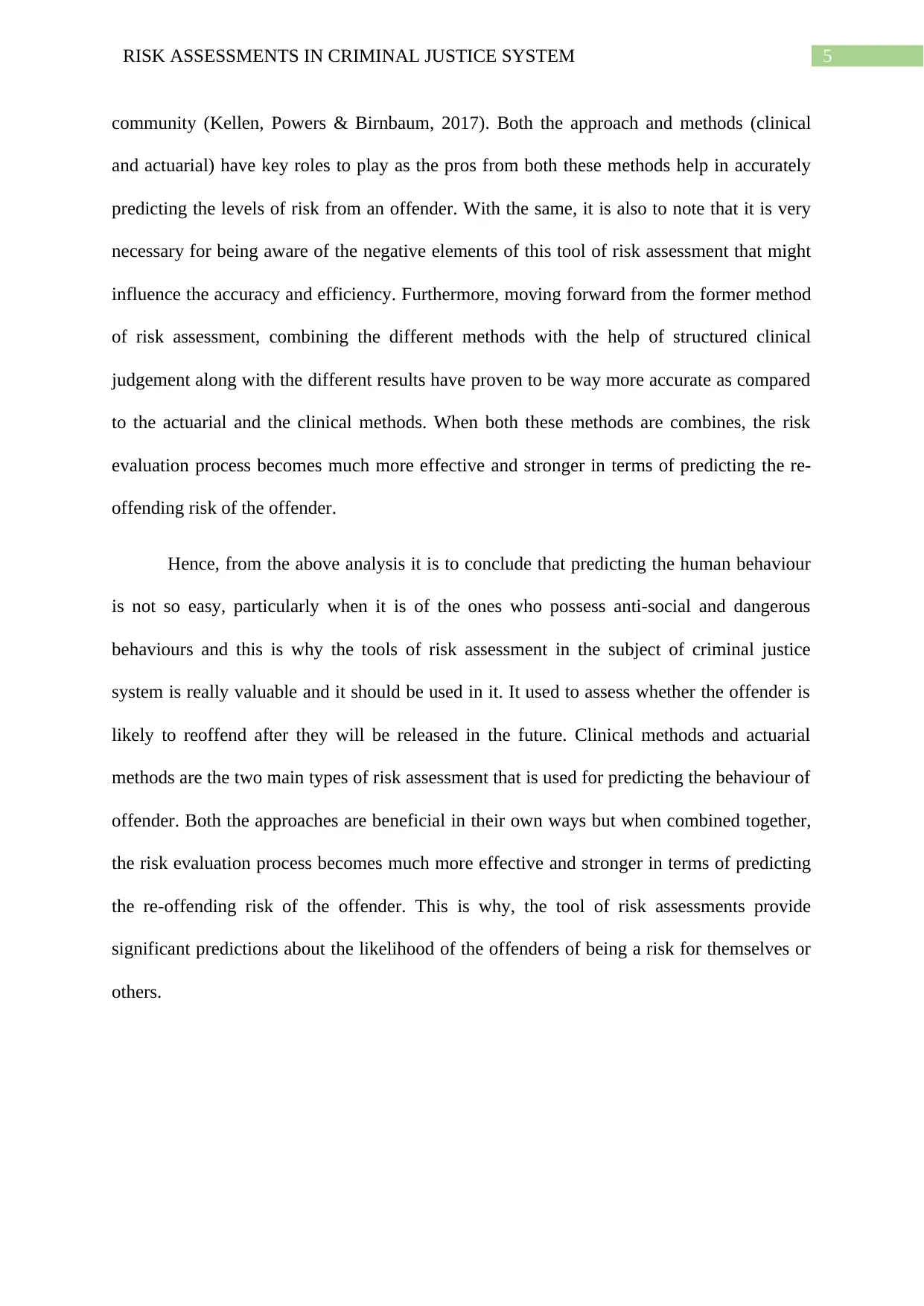
5RISK ASSESSMENTS IN CRIMINAL JUSTICE SYSTEM
community (Kellen, Powers & Birnbaum, 2017). Both the approach and methods (clinical
and actuarial) have key roles to play as the pros from both these methods help in accurately
predicting the levels of risk from an offender. With the same, it is also to note that it is very
necessary for being aware of the negative elements of this tool of risk assessment that might
influence the accuracy and efficiency. Furthermore, moving forward from the former method
of risk assessment, combining the different methods with the help of structured clinical
judgement along with the different results have proven to be way more accurate as compared
to the actuarial and the clinical methods. When both these methods are combines, the risk
evaluation process becomes much more effective and stronger in terms of predicting the re-
offending risk of the offender.
Hence, from the above analysis it is to conclude that predicting the human behaviour
is not so easy, particularly when it is of the ones who possess anti-social and dangerous
behaviours and this is why the tools of risk assessment in the subject of criminal justice
system is really valuable and it should be used in it. It used to assess whether the offender is
likely to reoffend after they will be released in the future. Clinical methods and actuarial
methods are the two main types of risk assessment that is used for predicting the behaviour of
offender. Both the approaches are beneficial in their own ways but when combined together,
the risk evaluation process becomes much more effective and stronger in terms of predicting
the re-offending risk of the offender. This is why, the tool of risk assessments provide
significant predictions about the likelihood of the offenders of being a risk for themselves or
others.
community (Kellen, Powers & Birnbaum, 2017). Both the approach and methods (clinical
and actuarial) have key roles to play as the pros from both these methods help in accurately
predicting the levels of risk from an offender. With the same, it is also to note that it is very
necessary for being aware of the negative elements of this tool of risk assessment that might
influence the accuracy and efficiency. Furthermore, moving forward from the former method
of risk assessment, combining the different methods with the help of structured clinical
judgement along with the different results have proven to be way more accurate as compared
to the actuarial and the clinical methods. When both these methods are combines, the risk
evaluation process becomes much more effective and stronger in terms of predicting the re-
offending risk of the offender.
Hence, from the above analysis it is to conclude that predicting the human behaviour
is not so easy, particularly when it is of the ones who possess anti-social and dangerous
behaviours and this is why the tools of risk assessment in the subject of criminal justice
system is really valuable and it should be used in it. It used to assess whether the offender is
likely to reoffend after they will be released in the future. Clinical methods and actuarial
methods are the two main types of risk assessment that is used for predicting the behaviour of
offender. Both the approaches are beneficial in their own ways but when combined together,
the risk evaluation process becomes much more effective and stronger in terms of predicting
the re-offending risk of the offender. This is why, the tool of risk assessments provide
significant predictions about the likelihood of the offenders of being a risk for themselves or
others.
⊘ This is a preview!⊘
Do you want full access?
Subscribe today to unlock all pages.

Trusted by 1+ million students worldwide
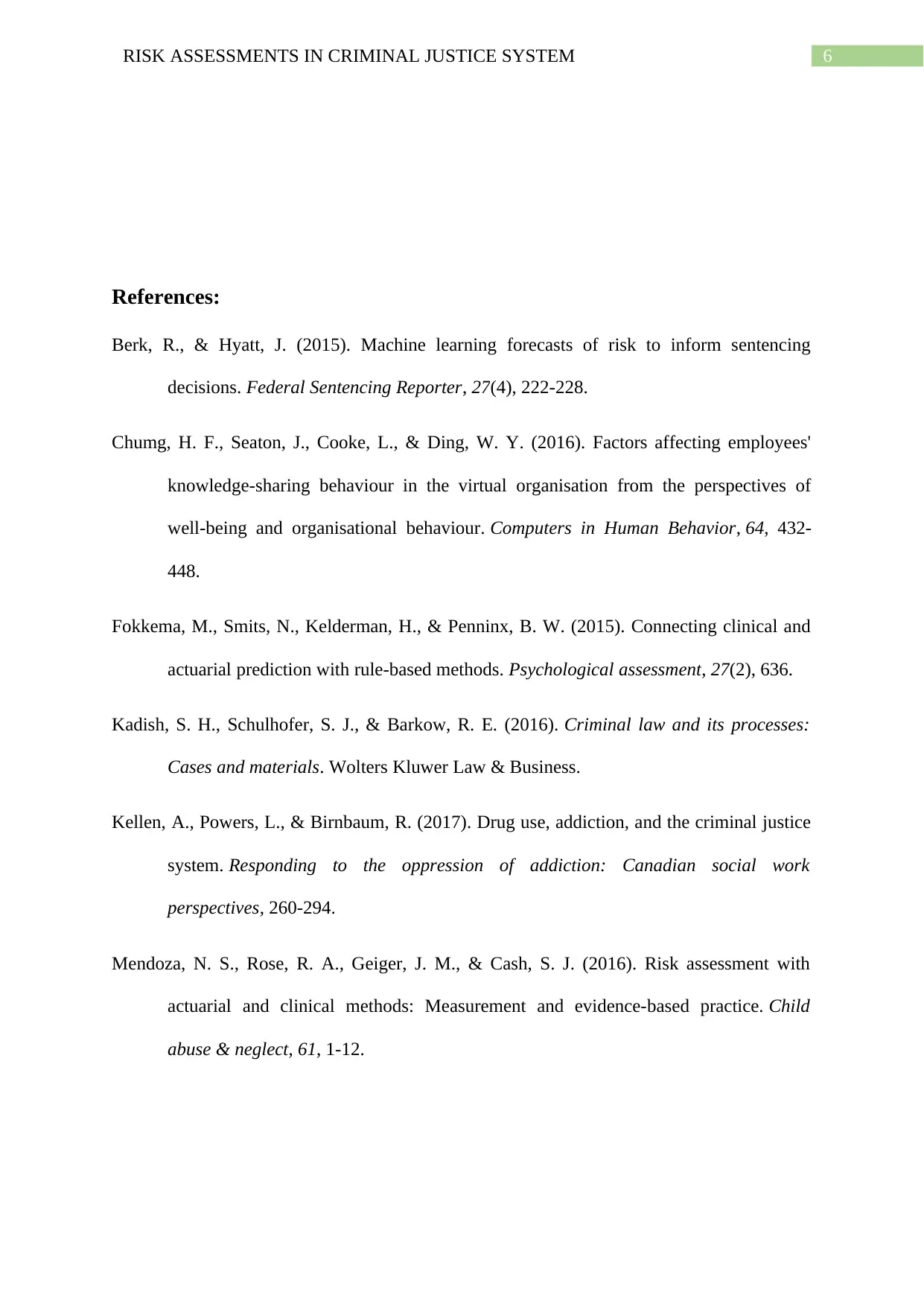
6RISK ASSESSMENTS IN CRIMINAL JUSTICE SYSTEM
References:
Berk, R., & Hyatt, J. (2015). Machine learning forecasts of risk to inform sentencing
decisions. Federal Sentencing Reporter, 27(4), 222-228.
Chumg, H. F., Seaton, J., Cooke, L., & Ding, W. Y. (2016). Factors affecting employees'
knowledge-sharing behaviour in the virtual organisation from the perspectives of
well-being and organisational behaviour. Computers in Human Behavior, 64, 432-
448.
Fokkema, M., Smits, N., Kelderman, H., & Penninx, B. W. (2015). Connecting clinical and
actuarial prediction with rule-based methods. Psychological assessment, 27(2), 636.
Kadish, S. H., Schulhofer, S. J., & Barkow, R. E. (2016). Criminal law and its processes:
Cases and materials. Wolters Kluwer Law & Business.
Kellen, A., Powers, L., & Birnbaum, R. (2017). Drug use, addiction, and the criminal justice
system. Responding to the oppression of addiction: Canadian social work
perspectives, 260-294.
Mendoza, N. S., Rose, R. A., Geiger, J. M., & Cash, S. J. (2016). Risk assessment with
actuarial and clinical methods: Measurement and evidence-based practice. Child
abuse & neglect, 61, 1-12.
References:
Berk, R., & Hyatt, J. (2015). Machine learning forecasts of risk to inform sentencing
decisions. Federal Sentencing Reporter, 27(4), 222-228.
Chumg, H. F., Seaton, J., Cooke, L., & Ding, W. Y. (2016). Factors affecting employees'
knowledge-sharing behaviour in the virtual organisation from the perspectives of
well-being and organisational behaviour. Computers in Human Behavior, 64, 432-
448.
Fokkema, M., Smits, N., Kelderman, H., & Penninx, B. W. (2015). Connecting clinical and
actuarial prediction with rule-based methods. Psychological assessment, 27(2), 636.
Kadish, S. H., Schulhofer, S. J., & Barkow, R. E. (2016). Criminal law and its processes:
Cases and materials. Wolters Kluwer Law & Business.
Kellen, A., Powers, L., & Birnbaum, R. (2017). Drug use, addiction, and the criminal justice
system. Responding to the oppression of addiction: Canadian social work
perspectives, 260-294.
Mendoza, N. S., Rose, R. A., Geiger, J. M., & Cash, S. J. (2016). Risk assessment with
actuarial and clinical methods: Measurement and evidence-based practice. Child
abuse & neglect, 61, 1-12.
Paraphrase This Document
Need a fresh take? Get an instant paraphrase of this document with our AI Paraphraser
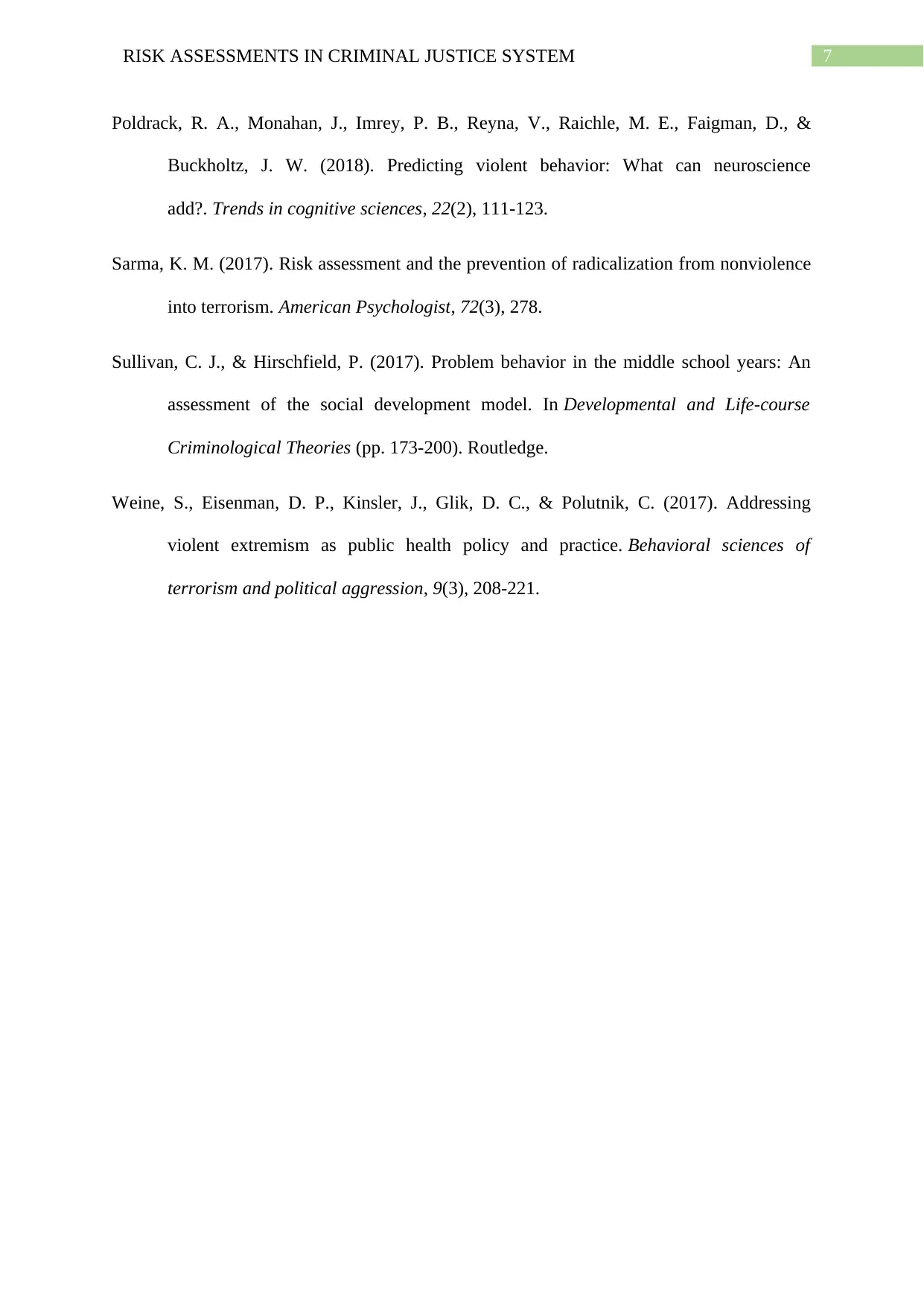
7RISK ASSESSMENTS IN CRIMINAL JUSTICE SYSTEM
Poldrack, R. A., Monahan, J., Imrey, P. B., Reyna, V., Raichle, M. E., Faigman, D., &
Buckholtz, J. W. (2018). Predicting violent behavior: What can neuroscience
add?. Trends in cognitive sciences, 22(2), 111-123.
Sarma, K. M. (2017). Risk assessment and the prevention of radicalization from nonviolence
into terrorism. American Psychologist, 72(3), 278.
Sullivan, C. J., & Hirschfield, P. (2017). Problem behavior in the middle school years: An
assessment of the social development model. In Developmental and Life-course
Criminological Theories (pp. 173-200). Routledge.
Weine, S., Eisenman, D. P., Kinsler, J., Glik, D. C., & Polutnik, C. (2017). Addressing
violent extremism as public health policy and practice. Behavioral sciences of
terrorism and political aggression, 9(3), 208-221.
Poldrack, R. A., Monahan, J., Imrey, P. B., Reyna, V., Raichle, M. E., Faigman, D., &
Buckholtz, J. W. (2018). Predicting violent behavior: What can neuroscience
add?. Trends in cognitive sciences, 22(2), 111-123.
Sarma, K. M. (2017). Risk assessment and the prevention of radicalization from nonviolence
into terrorism. American Psychologist, 72(3), 278.
Sullivan, C. J., & Hirschfield, P. (2017). Problem behavior in the middle school years: An
assessment of the social development model. In Developmental and Life-course
Criminological Theories (pp. 173-200). Routledge.
Weine, S., Eisenman, D. P., Kinsler, J., Glik, D. C., & Polutnik, C. (2017). Addressing
violent extremism as public health policy and practice. Behavioral sciences of
terrorism and political aggression, 9(3), 208-221.
1 out of 8
Related Documents
Your All-in-One AI-Powered Toolkit for Academic Success.
+13062052269
info@desklib.com
Available 24*7 on WhatsApp / Email
![[object Object]](/_next/static/media/star-bottom.7253800d.svg)
Unlock your academic potential
Copyright © 2020–2025 A2Z Services. All Rights Reserved. Developed and managed by ZUCOL.





